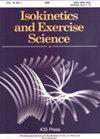Re-examination of hip flexion angle-moment characteristics
IF 0.6
4区 医学
Q4 ENGINEERING, BIOMEDICAL
引用次数: 0
Abstract
BACKGROUND: Hip flexion angle-moment may not be measured accurately due to the measurement posture. OBJECTIVE: Maximum isometric hip flexion moment was measured while excluding the effects of postural retention function and compensatory motion. METHODS: Experiment 1: Maximum isometric flexion moment of the hip joint was measured at 0∘, 30∘, 60∘, 90∘, and 105∘ in 195 participants. Experiment 2: Maximum isometric hip flexion moment of 33 participants was measured in standing and supine position at 0∘ hip flexion and in end-sitting and supine position at 105∘. RESULTS: Experiment 1: No interaction was observed between sex and hip angle, and hip flexion moment was minimum at 0∘ hip flexion and maximum at 105∘ hip flexion in both sexes (p< 0.01). Experiment 2: An interaction between measurement position and hip angle was observed, with maximum isometric flexion moment being greater in the supine position than in the standing position (p< 0.01). Maximum isometric hip flexion moment was greater at 105∘ than at 0∘ flexion (p< 0.01). CONCLUSIONS: Maximum isometric hip flexion moment showed greater joint angle-moment characteristics in deep flexion than in shallow flexion of the hip when excluding the effects of postural retention function and compensatory motion.重新审查髋关节屈曲角度-时刻特征
背景:由于测量姿势的原因,可能无法准确测量髋关节屈曲角矩。目的:在排除姿势保持功能和代偿运动影响的情况下,测量最大等长髋关节屈曲力矩。方法:实验 1:测量 195 名参与者髋关节在 0∘、30∘、60∘、90∘ 和 105∘时的最大等长屈曲力矩。实验 2:测量了 33 名参与者在站立和仰卧姿势下髋关节屈曲 0∘时的最大等长髋关节屈曲力矩,以及在端坐和仰卧姿势下髋关节屈曲 105∘时的最大等长髋关节屈曲力矩。结果:实验 1:没有观察到性别与髋关节角度之间的交互作用,髋关节屈曲力矩在 0∘髋关节屈曲时最小,在 105∘髋关节屈曲时最大(P< 0.01)。实验 2:测量位置和髋关节角度之间存在相互作用,仰卧位的最大等长屈曲力矩大于站立位(p< 0.01)。屈曲 105∘时的最大等长屈曲髋关节力矩大于屈曲 0∘时的最大等长屈曲髋关节力矩(p< 0.01)。结论:如果排除姿势保持功能和代偿运动的影响,最大等长髋关节屈曲力矩在髋关节深屈时比浅屈时显示出更大的关节角度-力矩特征。
本文章由计算机程序翻译,如有差异,请以英文原文为准。
求助全文
约1分钟内获得全文
求助全文
来源期刊

Isokinetics and Exercise Science
医学-工程:生物医学
CiteScore
1.20
自引率
14.30%
发文量
37
审稿时长
>12 weeks
期刊介绍:
Isokinetics and Exercise Science (IES) is an international journal devoted to the study of theoretical and applied aspects of human muscle performance. Since isokinetic dynamometry constitutes the major tool in this area, the journal takes a particular interest in exploring the considerable potential of this technology.
IES publishes studies associated with the methodology of muscle performance especially with respect to the issues of reproducibility and validity of testing, description of normal and pathological mechanical parameters which are derivable from muscle testing, applications in basic research topics such as motor learning paradigms and electromyography. The journal also publishes studies on applications in clinical settings and technical aspects of the various measurement systems employed in human muscle performance research.
The journal welcomes submissions in the form of research papers, reviews, case studies and technical reports from professionals in the fields of sports medicine, orthopaedic and neurological rehabilitation and exercise physiology.
 求助内容:
求助内容: 应助结果提醒方式:
应助结果提醒方式:


